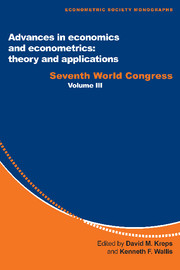Book contents
- Frontmatter
- 1 Causal analysis and statistical inference on possibly non-stationary time series
- 2 Cointegration, long-run comovements, and long-horizon forecasting
- 3 Testing and measurement in competition models
- 4 Empirical equilibrium search models
- 5 Posterior simulators in econometrics
- 6 Restricted least squares subject to monotonicity and concavity constraints
- 7 Bootstrap methods in econometrics: theory and numerical performance
- 8 Econometric models of option pricing errors
- 9 New minimum chi-square methods in empirical
- Index
7 - Bootstrap methods in econometrics: theory and numerical performance
Published online by Cambridge University Press: 05 January 2013
- Frontmatter
- 1 Causal analysis and statistical inference on possibly non-stationary time series
- 2 Cointegration, long-run comovements, and long-horizon forecasting
- 3 Testing and measurement in competition models
- 4 Empirical equilibrium search models
- 5 Posterior simulators in econometrics
- 6 Restricted least squares subject to monotonicity and concavity constraints
- 7 Bootstrap methods in econometrics: theory and numerical performance
- 8 Econometric models of option pricing errors
- 9 New minimum chi-square methods in empirical
- Index
Summary
INTRODUCTION
The bootstrap is a method for estimating the distribution of an estimator or test statistic by resampling the data. It amounts to treating the data as if they were the population for the purpose of evaluating the distribution of interest. Under mild regularity conditions, the bootstrap yields an approximation to the distribution of an estimator or test statistic that is at least as accurate as the approximation obtained from first-order asymptotic theory. Thus, the bootstrap provides a way to substitute computation for mathematical analysis if calculating the asymptotic distribution of an estimator or statistic is difficult. The maximum score estimator (Manski (1975, 1985)), the statistic developed by Härdle et al. (1991) for testing positive-definiteness of income-effect matrices, and certain functions of time-series data (Blanchard and Quah (1989), Runkle (1987), West (1990)) are examples in which evaluating the asymptotic distribution is difficult and bootstrapping has been used as an alternative.
In fact, the bootstrap is often more accurate in finite samples than first-order asymptotic approximations but does not entail the algebraic complexity of higher-order expansions. Thus, it can provide a practical method for improving upon first-order approximations. First-order asymptotic theory often gives a poor approximation to the distributions of test statistics with the sample sizes available in applications. As a result, the nominal levels of tests based on asymptotic critical values can be very different from the true levels.
Information
- Type
- Chapter
- Information
- Advances in Economics and Econometrics: Theory and ApplicationsSeventh World Congress, pp. 188 - 222Publisher: Cambridge University PressPrint publication year: 1997
Accessibility standard: Unknown
Why this information is here
This section outlines the accessibility features of this content - including support for screen readers, full keyboard navigation and high-contrast display options. This may not be relevant for you.Accessibility Information
- 53
- Cited by
